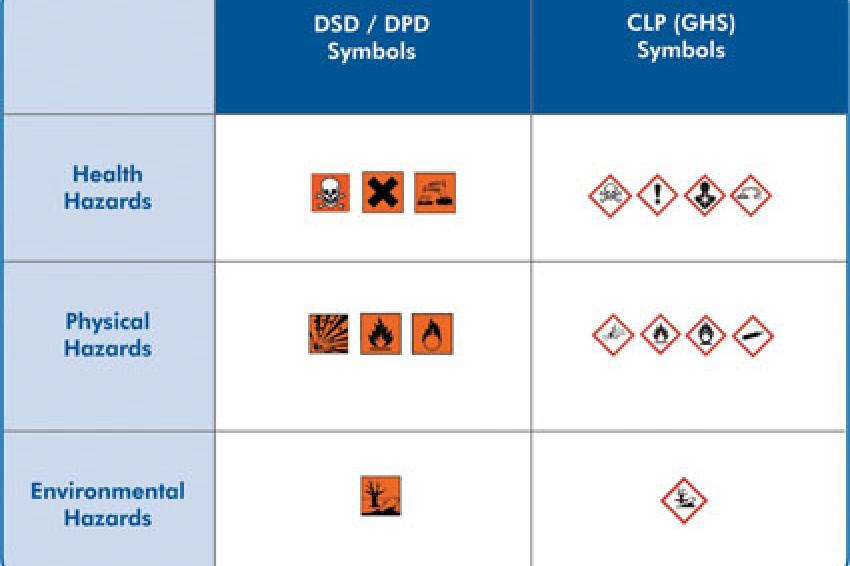Surviving Purple Fever
Navigating the Minefield of Labeling Under The CLP
Labeling is Mission Critical - Within the last several years, the industry has seen an unprecedented change in the legislation that impacts the chemical industry and users of chemicals. Reach and the Globally Harmonized System of Classification and Labeling of Chemicals (GHS) have been the main drivers.
The GHS addresses classification of chemicals by classes of hazard and proposes harmonized hazard communication elements, including labels and safety data sheets (SDS). It aims to ensure that information on physical hazards and toxicity from chemicals is available in order to enhance the protection of human health and the environment during the handling, transport and use of chemicals. GHS also provides a basis for harmonization of rules and regulations on chemicals at national, regional and worldwide level, an important factor also for trade facilitation. The EU has implemented the United Nations' GHS model regulation into EU law as the Classification, Labeling and Packaging (CLP) of chemical substances. CLP is currently based on the second revision of UN GHS.
CLP includes its own nuances, additional hazard classes, etc. and inherits some of the basic features and procedures from the Dangerous Substance Directive/Dangerous Preparation Directive (DSD and DPD). CLP will eventually supersede DSD and DPD. These catalyst legislations have changed the rules of the game when shipping products within the EU and external markets.
The European chemical industry is fortunate that CLP, like its predecessor, associates symbols based on the product/substance classification. When Occupational Health and Safety Association (OSHA) in the U.S. finally implements GHS, they will be introducing for the first time labeling based on prescribed symbols. The education and re-development of labeling will be a massive undertaking.
That said, in Europe we still have large hurdles to overcome. The starting point of how you manage and label your goods today plays a large part in how easy or difficult it will be to implement CLP labeling into your business. Labeling is mission critical. If a product can't be labeled to meet industry legislation, then it can't be shipped.
Labelling is Complex
So how should labeling be approached today? There are many different starting points and levels of sophistication and complexity.
- There is no standard methodology that companies use to implement labeling. It can be a standalone process handled at a business unit, country level or centralized within the corporation. Labelling may be outsourced to a third party. Regardless of the methodology used, there are numerous stakeholders including sales, marketing, EH&S and IT that are typically spread across the organization.
- Because labeling is mission critical, companies need to be able to label products 24 X 7, in multiple formats and in multiple languages. Hazard information needs to be made available in the native language of each country where the product will be transported/sold.
- Data for labels comes from multiple sources including the ERP system, EH&S, SDS systems and logistics.
- The actual physical printing of labels adds another dimension of complexity. There are different types of printer technologies such as laser and thermal and many different label substrates and inks (black and color). Labels may be pre-printed or images can be lithographed onto tins or consumer packaging.
- A company's supply chain, production and logistics play a large part in how they approach labeling and manage the associated costs.
Additional GHS/CLP Challenges
With CLP, some classification criteria is different to the DSD/DPD, or uses different cut-offs. In general the consensus within the industry is that more substances under GHS/CLP will be classified as hazardous. For example, under the new legislation, the flashpoint cut off for combustible/flammable liquids was increased from 55°C to 60°C (category 3 for flammability); current hazard symbols defined in DSD/DPD have been in place for years in Europe and are being replaced with CLP hazard pictograms; DSD/DPD has seven symbols whereas CLP has nine; the CLP pictograms are black symbols outlined by a red diamonds on a white background. An extra level of complexity will be added as the size of pictograms is not harmonized worldwide; currently, EU pictograms are specified at a different size than pictograms in Korea and Australia, etc.
Example Of Impact
Here is an example of the impact of the CLP for one marine paint company, who recently conducted an impact analysis on their product portfolio. Under the DSD/DPD, 47% of their labels required one hazard symbol and 46% required two hazard symbols. With CLP, the analysis showed that 16% of their products will require two pictograms, 63% will require three pictograms, and 10% will require four. With additional pictograms come additional signal words and hazard statements. Under CLP, 110 precautionary statements will replace 50 safety phrases needed under DSD/DPD. The regulation states, "Not more than six precautionary statements shall appear on the label, unless necessary to reflect the nature and the severity of the hazards."
Selection of these precautionary statements may be a complex process for some products, because there is currently no guidance on the use of each individual statement, as there was for the safety phrases. This is an issue that is currently under discussion at the level of the UN Economic Committee for Europe (UNECE) subcommittee of experts on the GHS.
So Much Information, So Little Space
The result of the additional pictograms and text means that greater pressure is applied to the space on the label; and the only way to reduce this is to reduce the number of languages printed. Many companies predict they will be able to print a third less languages on their labels which may force them to print additional labels.
To satisfy the need for more label space, firms have been exploring the use of different types of labels such as fan folded booklet labels. There is nothing in the legislation that prohibits fan fold labels, however some national authorities are discouraging the use of them.
Pre-printed label stock is very expensive and companies will have to review their label requirements due to the increase in pictograms. One favored option is to have one label with the maximum amount of pre-printed red diamond borders. This has initiated a lively discussion on what to do with the empty borders when all pictograms are not in use. Should they be left blank? Should they be blacked out? How will the end user interpret this? Forums are alive with discussions on this issue. It seems that several national authorities take a dim view on empty boxes this. Guidance from European Chemical Agency (ECHA) is expected soon.
Some companies may look to invest in color printers, or due to an increase in the need for label stocks they may purchase additional black printers. There has been no major advance in printer technology to support the new CLP labeling challenge. For colour printing, companies are limited to laser printers and most chemical companies use thermal printers with black ribbons (ink).
Time Line for New Changes
Organizations must re-classify and re-label their substances by Dec. 1, 2010. To help with products that are already in the supply chain, a further two year transition period, until Dec. 1, 2012, is also available for substances that are already classified, packaged and labelled, and placed on the market i.e. already "on the shelf", before Dec. 1, 2010.
Mixtures must be re-classified and re-labelled by June 1, 2015. Similarly to substances, a further two year transition period, until June 1, 2017, is available for mixtures that are already classified, packaged and labelled, and placed on the market i.e. already "on the shelf" before June 1, 2015.
CLP as an Agent of Change
Although there are a number of challenges when making the transition to a CLP-compliant system, the CLP provides an opportunity to consolidate and streamline processes from a global perspective. Here are 10 steps that companies can take to review their existing solutions and ensure a smooth transition.
- Monitor country adoption of GHS/CLP - Stay current with legislation changes and adoption so that you can keep your plan on track. Your process needs to be able to track country-specific requirements, alert you to any changes, and assess the speed in which you can implement changes.
- Maintain dialogue with stakeholders - Involve all stakeholders including sales, marketing, logistics and IT at the beginning of the assessment, and throughout the whole process, not when it is completed.
- Run impact analyses on product portfolio - The ability to run an automated impact analysis and classification across the entire product portfolio at one time provides the opportunity to assess the impact for R&D, sales and the supply chain.
- Set up a time line - Work backwards from the deadline and take into consideration the shelf life of your products (mixtures). If the deadline is EU 2017 (product already in supply chain) and the shelf life is five years, then the product needs to be re-labeled by 2012.
- Review approach to labeling, consolidation, optimization - Consider consolidating data sources and streamlining processes.
- Review purchasing agreements, stocks, labels, cans, etc. - Ensure that there are no long-term agreements in place with pre-defined delivery dates of label stock, and pre-printed packaging. Run down old stocks of pre-printed labels and packaging to minimize cost and waste.
- Review label design and stock - Determine if the current design, type and stock can handle CLP changes. Label designs need to maximize space to avoid companies introducing new stock keeping units (SKU) to handle the language requirements. New requirements require a solution that can provide symbols with and without borders as well as logic to combine GHS and transport symbols where appropriate.
- Review the logistics cycle - Determine if the production run is for stock or order, introduce new label concepts, re-labeling when destination known, etc.
- Review IT infrastructure for labeling and hazard communication - The key to ensuring accuracy is consistency. Guarantee that the data sources driving the label are reliable and consistent. Changes in the underlying data set for the formula or SDS should be able to be handled at the same time. Hazard communication needs to be driven from one platform or from one consistent framework.
Determine costs - The sooner you start to digest the impact of the CLP on your business and especially labeling, the lower the cost will eventually be to your company as more solutions will be available to you.






